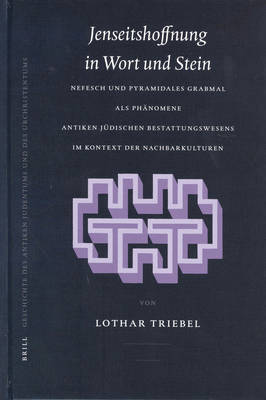
- Afhalen na 1 uur in een winkel met voorraad
- Gratis thuislevering in België vanaf € 30
- Ruim aanbod met 7 miljoen producten
- Afhalen na 1 uur in een winkel met voorraad
- Gratis thuislevering in België vanaf € 30
- Ruim aanbod met 7 miljoen producten
Zoeken
Jenseitshoffnung in Wort Und Stein
Nefesch Und Pyramidales Grabmal ALS Phänomene Antiken Jüdischen Bestattungswesens Im Kontext Der Nachbarkulturen
Lothar Triebel
Hardcover | Duits, Oudgrieks, Hebreeuws | Arbeiten Zur Geschichte Des Antiken Judentums Und Des Urchri | nr. 56
€ 393,95
+ 787 punten
Omschrijving
This monograph deals with two phenomena of ancient (hellenistic and roman times) Jewish burial customs: The use of the term "nefesh" for denoting a tomb-monument etc. and the use of the pyramid as a distinct feature of tomb architecture and of decoration of burial sites. Every instance of Jewish use of either the term or the pyramid will be analysed, as well as a couple of instances from neighbouring cultures and languages (especially Nabatea and Palmyra). The widespread opinion that "nefesh" denotes specifically a pyramid is to be falsified. Palestinian Jewish burial customs turn out to be deeply embedded into their semitic environment. Finally the hypothesis is advanced that the pyramid often symbolizes a concept of afterlife. About 50 plates with ca. 200 photos and drawings accompany the text.
Specificaties
Betrokkenen
- Auteur(s):
- Uitgeverij:
Inhoud
- Aantal bladzijden:
- 343
- Taal:
- Duits, Oudgrieks, Hebreeuws
- Reeks:
- Reeksnummer:
- nr. 56
Eigenschappen
- Productcode (EAN):
- 9789004129245
- Verschijningsdatum:
- 19/02/2004
- Uitvoering:
- Hardcover
- Formaat:
- Genaaid
- Afmetingen:
- 166 mm x 246 mm
- Gewicht:
- 911 g

Alleen bij Standaard Boekhandel
+ 787 punten op je klantenkaart van Standaard Boekhandel
Beoordelingen
We publiceren alleen reviews die voldoen aan de voorwaarden voor reviews. Bekijk onze voorwaarden voor reviews.








